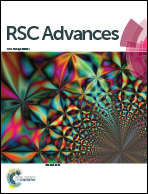Fe substitution in urchin-like NiCo2O4 for energy storage devices†
Abstract
A composite of NiCo2−xFexO4 was designed to investigate the effects of Fe substitution on its energy storage performance. Urchin-like products composed of nanowires were successfully synthesized through the hydrothermal method and calcinations. Scanning electron microscopy (SEM) images revealed that Fe substitution could reduce the diameter of the nanowires and hinder the urchin-like sphere construction. X-ray diffraction (XRD), energy dispersive X-ray mapping (EDS-mapping) and X-ray photoelectron spectroscopy (XPS) revealed the successful Fe substitution for Co. More importantly, the specific capacity could be largely improved from 359 C g−1 (826 F g−1) for x = 0 to 523 C g−1 (1188 F g−1) for x = 0.3 at 1 A g−1. Moreover, with x = 0.3, a specific capacity of 788 F g−1 could be maintained as the current density was increased to 20 A g−1. Asymmetric supercapacitors based on this compound exhibited an energy density of 26.6 W h kg−1 at a power density of 370 W kg−1.



 Please wait while we load your content...
Please wait while we load your content...